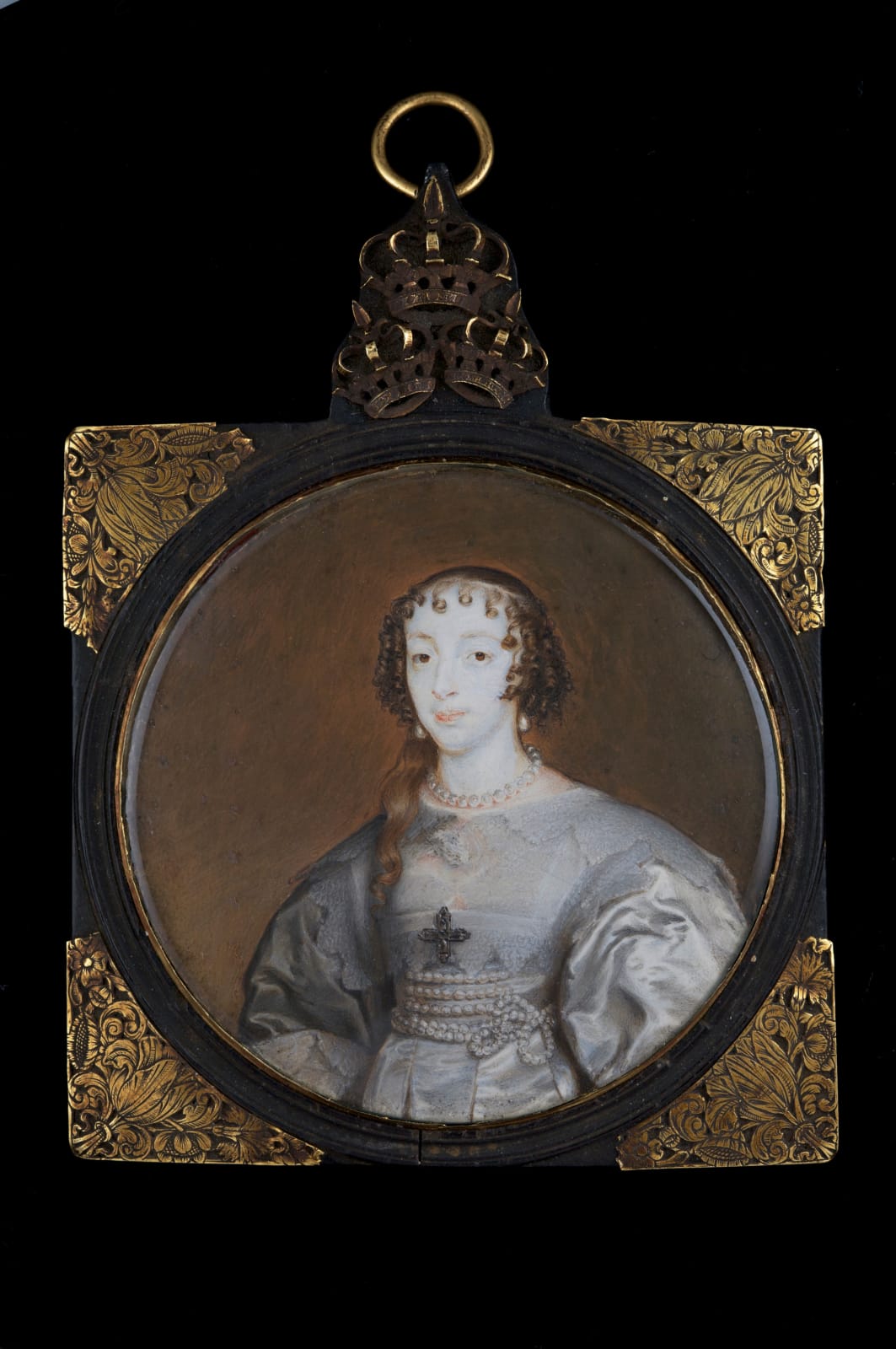
Alexander Cooper
A portrait of Henrietta Maria (1609-69), Queen of Charles I , c. 1642
Watercolour on vellum
Circular, 60mm. (2 3/8ins.) diam.
Philip Mould & Co.
To view all current artworks for sale visit philipmould.com Seventeenth century square wood frame, the gilt-metal corners engraved with flowers, including tulips, the whole surmounted with three crowns. This...
To view all current artworks for sale visit philipmould.com
Seventeenth century square wood frame, the gilt-metal corners engraved with flowers, including tulips, the whole surmounted with three crowns.
This beautifully rendered portrait of Henrietta Maria is clearly based upon the various images of the queen painted during the 1630s by Sir Anthony Van Dyck (1599–1641) but it has not been possible to identify the exact source. By the 17th century in England, the circular format for portrait miniatures was considered antiquated but has possibly been used in this instance to emulate the feel and composition of a small oil painting. The image is a fascinating, and rather curious, addition to the existing iconography of Henrietta Maria.
Although she was not regarded as a great beauty, artists responded to her warm personality and in fact visitors were often shocked to find that the Queen was most unlike her portraits (Prince Rupert's youngest sister, Sophia was surprised to find the Queen to be a small, badly-postured woman with ''teeth protruding from her mouth like guns from a fort'').The seventeenth century frame, probably the original, is most unusual and a possible clue to the date of the miniature. In 1642, Henrietta Maria fled to Holland with the crown jewels to raise men and money. The inclusion of tulips in the engraved corners of the frame suggests that it was a gift to a Royalist supporter in Holland.
Both oil painters and miniaturists were kept occupied at this time producing royal images for court supporters in England and abroad. It has only been possible to attribute the portrait miniature to Alexander Cooper based on the technique and the fact that he was in Holland during the 1640s. The wealth of detail in the costume and the delicate handling of the watercolour are both trademarks of Samuel Cooper’s itinerant brother.
After 1648, Henrietta Maria became solely dependent upon the good will of others for her livelihood. Impoverished and forced to leave France she was not to return again to England until 1660. Amidst failing health and what she perceived to be an English indifference to her sufferings, she died near Paris after ingesting opium.
Seventeenth century square wood frame, the gilt-metal corners engraved with flowers, including tulips, the whole surmounted with three crowns.
This beautifully rendered portrait of Henrietta Maria is clearly based upon the various images of the queen painted during the 1630s by Sir Anthony Van Dyck (1599–1641) but it has not been possible to identify the exact source. By the 17th century in England, the circular format for portrait miniatures was considered antiquated but has possibly been used in this instance to emulate the feel and composition of a small oil painting. The image is a fascinating, and rather curious, addition to the existing iconography of Henrietta Maria.
Although she was not regarded as a great beauty, artists responded to her warm personality and in fact visitors were often shocked to find that the Queen was most unlike her portraits (Prince Rupert's youngest sister, Sophia was surprised to find the Queen to be a small, badly-postured woman with ''teeth protruding from her mouth like guns from a fort'').The seventeenth century frame, probably the original, is most unusual and a possible clue to the date of the miniature. In 1642, Henrietta Maria fled to Holland with the crown jewels to raise men and money. The inclusion of tulips in the engraved corners of the frame suggests that it was a gift to a Royalist supporter in Holland.
Both oil painters and miniaturists were kept occupied at this time producing royal images for court supporters in England and abroad. It has only been possible to attribute the portrait miniature to Alexander Cooper based on the technique and the fact that he was in Holland during the 1640s. The wealth of detail in the costume and the delicate handling of the watercolour are both trademarks of Samuel Cooper’s itinerant brother.
After 1648, Henrietta Maria became solely dependent upon the good will of others for her livelihood. Impoverished and forced to leave France she was not to return again to England until 1660. Amidst failing health and what she perceived to be an English indifference to her sufferings, she died near Paris after ingesting opium.
Provenance
English Private Collection1
of
3